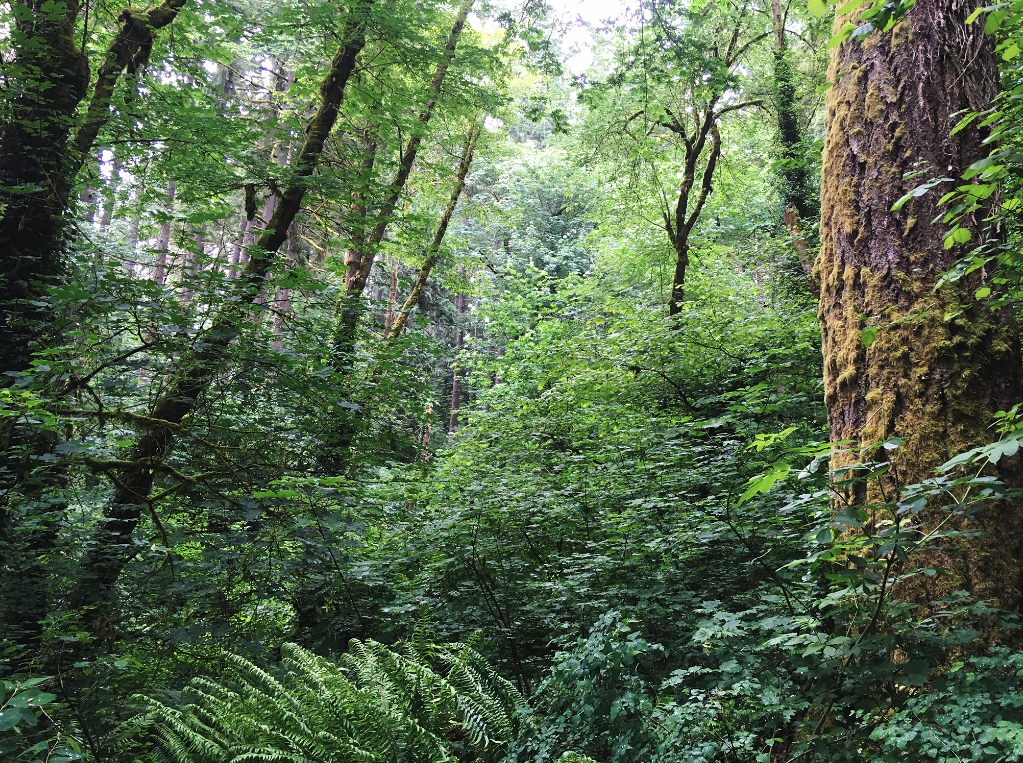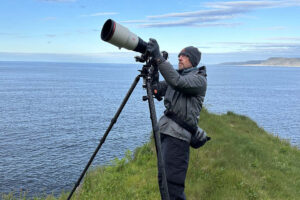
By Charlotte Persons
What are “legacy forests”? These are NOT “old growth” forests, defined as undisturbed forests with trees at least 120 years old or an average tree diameter of ten inches. Instead, legacy forests were timbered, but before the end of World War II. In that era, mature trees were removed from forests, but smaller trees and the understory were basically left undisturbed. After that time bigger machinery was used to clearcut forests of most trees and brush. All vegetation was removed by burning or with chemicals to prepare for planting regularly-spaced nursery trees of one tree species—modern tree farms or tree plantations.
In contrast, a legacy forest has never been planted. A legacy forest harvested more than 70 years ago has regrown with trees of different species and ages and has high levels of forest floor vegetation. Many legacy forests have trees from 80 to 90 years old. Studies show that legacy forests withstand disease and drought better than monoculture tree plantations. Their more mature trees and denser vegetation also sequester much more carbon dioxide, a greenhouse gas that contributes to global warming. Even relatively young legacy forests provide good habitat for native plants and wildlife—and in a few decades, if spared timbering, they will be “old growth” forests.
Why is the Department of Natural Resources (DNR) selling so many timber parcels of legacy forest in Western Washington? Demand for timber in state forests is now higher than during the years following the 2008 recession, and the timber industry prizes legacy forests with mature trees.
Higher numbers of legacy forest timber sales are also one unfortunate result of the Marbled Murrelet Long Term Conservation Strategy (LTCS) that was finalized in 2019. Marbled Murrelets are listed as endangered in our state, live in coastal waters, and breed in the top canopy of old-growth trees surrounded by mature forests.
Audubon members from five chapters fought for over eight years for a conservation strategy for DNR forests that would prevent the bird from becoming extinct in our state. They were disappointed in the final version of the LTCS. Only 6 more square miles of forest in the entire state were conserved than in the previous temporary conservation strategy, and the LTCS actually predicts the extinction of Marbled Murrelets in Washington within 50 years.
Adoption of the LTCS has also left unprotected 30,000 acres of mature state forest within 60 miles of Puget Sound that were previously under consideration to be conserved. Those DNR lands are now available for harvest.
Where are legacy forests? According to the Center for Responsible Forestry, 63,000 acres of DNR forest land in Western Washington meet the criterion of being unplanted and having trees over 100 years old. Last year DNR sold 15,000 acres of legacy forest, and 3,200 more acres are to be sold this year. For a map of legacy forests in Western Washington, go to https://www.c4rf.org/
In the next two years, about fifty DNR legacy forest timber sales will be within BHAS’s region of Thurston, Mason, and Lewis Counties. You may have read in the local press about citizen actions and letters from county commissioners to protest particular timber sales. While some sales have gone forward, the Juneau sale near Littlerock in Thurston County (partly in the Capital Forest) and the Upper Rusatz sale near Deming and Bellingham in Whatcom County has currently been paused.
What can YOU do to protect legacy forests?
Monday, April 3: Call Hillary Franz, Commissioner of Public Lands, at 360-902-1000. Be part of a phone campaign to request a moratorium on timbering legacy forests. Leave a voicemail if her assistant doesn’t pick up. For more details, email Lynn Fitz-Hugh of Friends of Trees at Lynn@fitz-hugh.org
Sunday, April 2 or Sunday, April 9: Learn how to survey upcoming timber sales. Surveying will give you hands-on experience of upcoming timber sales. You will gain valuable skills in botany, ecology, and navigation, and gather information for influencing policymakers on behalf of legacy forests. The training will be leisurely hikes through upcoming important timber sale units. Terrain will be mostly flat, but the group will be bushwhacking through some shrubbery for most of the time. Rain gear, snacks, warm layers, drinking water, and binoculars are highly recommended. To sign up for this training, email Jim Oliver of the Center for Responsible Forestry at southsound@c4rf.org
Before April 24: Sign a petition that asks the state legislature to provide funding during the current legislative session for buying and protecting forests. Go to Conservation Northwest’s petition at https://act.newmode.net/action/conservation-northwest/ask-wa-state-leaders-save-our-most-carbon-dense-forests
Ongoing: Participate in protest actions at Board of Natural Resources meetings on the first Tuesday of each month. For more information, contact me at cpeople2u@gmail.com
Photo credit: PNW Forest, by Rachel Hudson.







